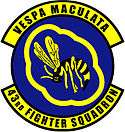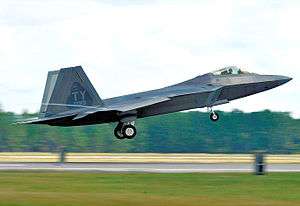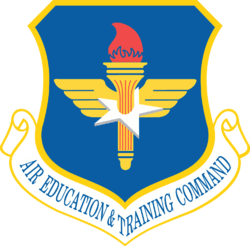43d Fighter Squadron
| 43d Fighter Squadron | |
|---|---|
|
43d Fighter Squadron Lockheed Martin Block 10 F-22A Raptor 00-4013 The aircraft crashed near Tyndall AFB on 15 November 2012. The pilot ejected safely. | |
| Active |
13 June 1917 – 17 April 1919 7 July 1922 – 1 September 1936 1 February 1940 – 15 October 1946 8 January 1964 – 1 January 1994 1 October 2002 – present |
| Country | United States |
| Branch | United States Air Force |
| Type | Fighter Training |
| Part of |
Air Combat Command 9th Air Force 325th Fighter Wing 325th Operations Group |
| Garrison/HQ | Tyndall Air Force Base |
| Nickname(s) | Hornets |
| Engagements |
World War I World War II Korean War Vietnam |
| Decorations |
|
| Insignia | |
| 43d Fighter Squadron emblem |
 |
The 43d Fighter Squadron (43 FS) is part of the 325th Fighter Wing at Tyndall Air Force Base, Florida. It conducts advanced fighter training for F-22 Raptor pilots.
The squadron is one of the oldest in the United States Air Force, its origins dating to 13 June 1917, being organized at Kelly Field, Texas. The squadron deployed to England as part of the American Expeditionary Force during World War I. The squadron saw combat during World War II, served in the Vietnam War and later became part of the Alaskan Air Command (AAC) during the Cold War.
Mission
The 43d Fighter Squadron is responsible for providing air dominance training for the F-22 Raptor.[1]
History
World War I
The 43d Fighter Squadron traces its lineage to the 43d Aero Squadron, first activated 13 June 1917, at Camp Kelly, Texas. In March 1918, the squadron moved to England, where it trained until reassigned to France on 1 November 1918 - just 10 days before the Armistice that ended World War I was signed. Having never seen combat, the squadron was demobilized in April 1919.[1]
Inter-war years
The 43d was reactivated on 22 July 1922, at Kelly Field, Texas, and was redesignated the 43d School Squadron in January 1923. The squadron flew various aircraft, including the DH-4, Spad XIII, SE-5, MB-7, AT-4, AT-5, PW-9, P-1, and P-12. The 43d became known as the "Hornets" as depicted by their emblem, a poised Vespa Maculata, or American "Yellow Jacket," the most formidable of the wasp family, surrounded by an ovate cloud. The emblem was approved in 1924 and the Hornet signifies the speed, agility and hard-hitting capabilities of the squadron while the cloud represents their domain - the skies.[1] In March 1935, the 43d was redesignated the 43d Pursuit Squadron, flying as part of the 3d Wing Advanced Flying School until it was inactivated in September 1936.
World War II

Re-established in 1939 as the 43d Pursuit Squadron (Interceptor) and activated on 1 February 1940 at Albrook Field, Panama Canal Zone. This unit was part of the build-up of the Canal Zone's defenses as war approached. Assigned to the 16th Pursuit Group (Interceptor), and equipped with Curtis P-36A Hawks. In July 1941, the Squadron began to convert from P-36A's to new Curtiss P-40 Warhawks and, upon completion of this conversion, 'A" Flight was transferred to the Top Secret "Project X" on 18 August. This, of course, was the reinforcement of Trinidad. Another flight later moved on to Zandery Field, Surinam, by January 1942.
After the Japanese Attack on Pearl Harbor, the unit moved to La Joya #1 (Pacora) Airfield in Panama in January 1942. In Panama, the squadron was assigned to the Panama Interceptor Com¬mand (PIC). Re-designated as the 43d Fighter Squadron on 13 June 1942. On 20 August, the squadron began re-equipping with the new Bell P-39 Airacobra, while the Zandery Field and Trinidad detachments remained. active with P-40Cs On 1 September the detachments aircraft were reassigned to the XXXVI Fighter Command, Antilles Air Task Force, although its personnel returned home to the main body of the Squadron.
Operating air defense patrols throughout 1943 from La Joya, pn 9 February 1944, the Squadron finally moved to Howard Field, having been deployed to an auxiliary base longer than any other Squadron in Sixth Air Force. In March, the Squadron was selected to serve as a "model" squadron for the Brazilian 1st Fighter Squadron, which was in training with the 30th Fighter Squadron at Aguadulce Field. During this operational observation, four Brazilian officers and 36 enlisted men were briefly attached to the Squadron. Moved back to Howard Field in August 1943. One more move was made to France Field on 10 January 1945, replacing the 32d Fighter Squadron.
Unit activities ran down with the end of the war in Europe in May 1945. The squadron ceased all flying activities in June. By October 1945, the squadron was reduced to a non-operational administrative organization. Inactivated on 15 October 1946.
Vietnam War

The squadron lay dormant nearly two decades before it was awakened as the 43d Tactical Fighter Squadron at MacDill Air Force Base, Florida, in January 1964 flying the F-84 Thunderstreak. The Hornets converted from the F-84 to the F-4 Phantom II, and in August 1965, deployed to Clark Air Base, Philippines, where they were in reserve support to the 47th Tactical Fighter Squadron who were flying combat missions over Southeast Asia from Ubon Royal Thai Air Force Base, Thailand.[1]
In November 1965, the Hornets became the first fighter squadron assigned to Cam Ranh Air Base, South Vietnam, with an advance party arriving on 28 October. During its time in Southeast Asia, the squadron flew 1,207 combat missions and earned the Air Force Outstanding Unit Award for its service. In January 1966, the 43rd TFS returned to MacDill AFB, to serve as an F-4 replacement-training unit until March 1970.[1]
Alaskan Service

In June 1970, the 43 TFS was moved to Elmendorf Air Force Base, Alaska, under the 21st Tactical Fighter Wing. The squadron was one of two units assigned to Alaskan Air Command. Flying the F-4E Phantom II, the 43d inherited a dual mission of Alaskan air defense and close air support for U.S. Army forces. In addition to flying out of Elmendorf AFB in Anchorage, the squadron also sat air defense alert at King Salmon, Galena, and Eielson AFB forward operating bases.
The squadron assumed North American Aerospace Defense Command air defense alert in October 1970 and between 1970 and 1982, the squadron's pilots intercepted more than 100 Soviet aircraft in Alaskan air space.[1] In 1976 the 43rd TFS won the Hughes Trophy for the best air-to-air squadron in the United States Air Force.
In 1982, the 43d became the first squadron to convert to the F-15 Eagle. Without help from a combat ready unit, the squadron developed its own F-15 training program and completed the first ever F-15 low runway condition reading tests. The squadron continued to provide air defense for North America until 1 January 1994, when it was inactivated.[1]
Modern era
On 25 October 2002, The 43d Fighter Squadron was reactivated with a new mission and a new aircraft. Assigned to the 325th Fighter Wing, Air Education and Training Command, Tyndall Air Force Base, Florida, the 43 FS is the first squadron to provide training for Air Force pilots in the F-22 Raptor.[1] The squadron transitioned to Air Combat Command when the 325th Fighter Wing assumed an operational mission, however the 43 FS continued to train Raptor pilots
Lineage
- Organized as 43d Provisional Squadron on 13 June 1917
- Re-designated 43d Aero Squadron on 26 June 1917
- Demobilized on 17 April 1919
- Reconstituted and consolidated (1924) with the 43d School Squadron (which was authorized on 10 June 1922
- Organized as the 43d Squadron [School] on 7 July 1922
- Re-designated 43d School Squadron on 25 January 1923
- Re-designated 43d Pursuit Squadron on 1 March 1935
- Inactivated on 1 September 1936
- Disbanded on 1 January 1938
- Consolidated (1939) with the 43d Pursuit Squadron (Interceptor) which was constituted on 22 December 1939.
- Activated on 1 February 1940
- Re-designated: 43d Fighter Squadron on 15 May 1942
- Re-designated: 43d Fighter Squadron, Single Engine on 12 April 1944
- Re-designated: 43d Fighter Squadron, Two Engine on 13 January 1945
- Re-designated: 43d Fighter Squadron, Single Engine on 8 January 1946
- Inactivated on 15 October 1946
- Re-designated 43d Tactical Fighter Squadron, activated, and organized, on 8 January 1964
- Re-designated 43d Fighter Squadron on 26 September 1991
- Inactivated on 1 January 1994
- Activated on 1 October 2002.
Assignments
|
|
Stations
|
|
Aircraft
|
|
Operations[2]
See also
References
![]() This article incorporates public domain material from the Air Force Historical Research Agency website http://www.afhra.af.mil/.
This article incorporates public domain material from the Air Force Historical Research Agency website http://www.afhra.af.mil/.
Bibliography
- Maurer, Maurer, ed. (1982) [1969]. Combat Squadrons of the Air Force, World War II (PDF) (reprint ed.). Washington, DC: Office of Air Force History. ISBN 0-405-12194-6. LCCN 70605402. OCLC 72556.
- Hagdedorn, Dan (1995), Alae Supra Canalem: Wings Over the Canal, Turner Publishing, ISBN 1-56311-153-5
- 43d Fighter Squadron Fact Sheet

